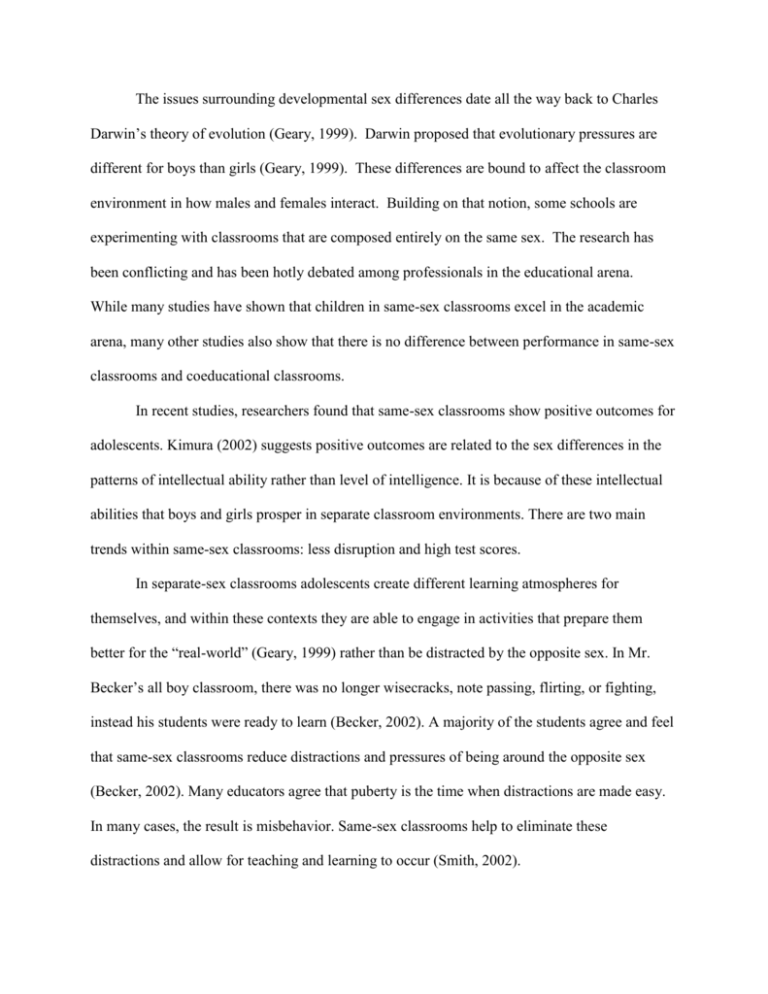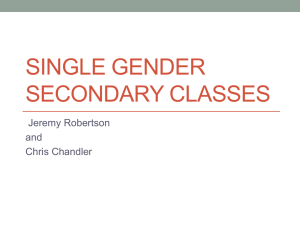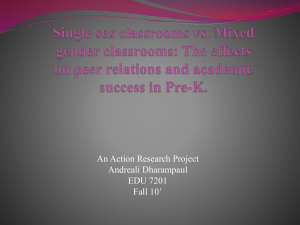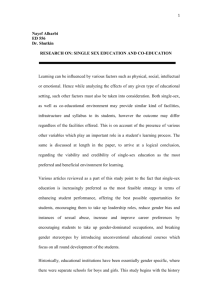Click here for an example of my work
advertisement

The issues surrounding developmental sex differences date all the way back to Charles Darwin’s theory of evolution (Geary, 1999). Darwin proposed that evolutionary pressures are different for boys than girls (Geary, 1999). These differences are bound to affect the classroom environment in how males and females interact. Building on that notion, some schools are experimenting with classrooms that are composed entirely on the same sex. The research has been conflicting and has been hotly debated among professionals in the educational arena. While many studies have shown that children in same-sex classrooms excel in the academic arena, many other studies also show that there is no difference between performance in same-sex classrooms and coeducational classrooms. In recent studies, researchers found that same-sex classrooms show positive outcomes for adolescents. Kimura (2002) suggests positive outcomes are related to the sex differences in the patterns of intellectual ability rather than level of intelligence. It is because of these intellectual abilities that boys and girls prosper in separate classroom environments. There are two main trends within same-sex classrooms: less disruption and high test scores. In separate-sex classrooms adolescents create different learning atmospheres for themselves, and within these contexts they are able to engage in activities that prepare them better for the “real-world” (Geary, 1999) rather than be distracted by the opposite sex. In Mr. Becker’s all boy classroom, there was no longer wisecracks, note passing, flirting, or fighting, instead his students were ready to learn (Becker, 2002). A majority of the students agree and feel that same-sex classrooms reduce distractions and pressures of being around the opposite sex (Becker, 2002). Many educators agree that puberty is the time when distractions are made easy. In many cases, the result is misbehavior. Same-sex classrooms help to eliminate these distractions and allow for teaching and learning to occur (Smith, 2002). In same-sex classrooms there is a substantial improvement in test scores (Becker, 2002). The students are taught by teachers of their gender and therefore a mentor/mentoree situation takes place. Also, the students are receiving enhanced educational opportunities because girls are able to more comfortably explore their interests in advanced math, science, and computer technology; while boys are able to explore their interests in art, music, drama, and languages (Smith, 2002). The students are being intellectually challenged every day and test scores reflect this. Although some studies have shown positive aspects of single-sex classrooms, some officials argue there is no conclusive evidence that single-sex schools are better than coeducational schools (AAUW, 2003). There is no consensus among psychologists as to the differences in males and females on the basis of psychological well-being and cognitive skills (Kaminer, 1998). The abilities of males and females vary depending upon the individual, and there is significant overlap in the skills they can perform (Rodgerson, 7/16). The puzzling question is whether single-sex schools are even necessary based on the overlap of skills and relative similarities between the sexes. Single-sex schools in California have created problems that were unforeseen by the researchers (Zwerling, 2003). Traditional gender stereotypes were reinforced at the single-sex academies (Zwerling, 2003). Boys were taught in a more regimented and individualistic style, while girls were taught in a nurturing and cooperative environment (Zwerling, 2003). It was reported that in one chemistry class for girls that neatness was stressed and parallels were made between activities and domesticity (Kaminer, 1998). Future employers could also legitimately question whether males and females will develop good interpersonal and communication skills with the opposite sex based on these different learning environments. Deborah Ross, executive director of the ACLU of North Carolina stated, “it creates the perception that men and women cannot work together on intellectual things as teams. What does that say when you go out into the workplace?” (2000). Another problem that was created by single-sex schools is that harassment continued and stereotypes were perpetuated (Zwerling, 2003). Within the single-sex school community boys were seen as bad, and girls were seen as good (Zwerling, 2003). Boys developed the notion that they need to be strong in order to take care of their emotionally weaker wives (Zwerling, 2003). Girls were told they could be anything they want; yet they had to abide by strict expectations about their clothing and appearance (Zwerling, 2003). Wendy Kaminer has said, “only as sexes have become less separate have women become more free” (1998). With findings as conflicting as those mentioned in this paper, the debate over same-sex schooling is obviously not likely to subside soon. Conclusive findings that holds true on every test has yet to be found. Thus, there is little consensus among educational professionals (Kaminer, 1998). Professionals need to be aware of both the benefits and liabilities of same-sex schooling and make an educated, personal decision on the matter. WORKS CITED American Association of University Women (2003). Single-Sex Education [Electronic Version]. Retrieved on July 17, 2003, from http://www.aauw.org/takeaction/policyissues/pdfs/SingleSexEducation.pdf. Becker, Jerry. “Single-sex classrooms gaining favor by Jerry Becker.” Online Posting. 18 Sept. 2002. Mathematics Education News. 14 July 2003. http://mathforum.org/epigone/mathed-news/flarnoutwir Geary, David. (1999) “Evolution and Developmental Sex Differences.” Current Directions in Psychological Science. United Kingdom: Blackwell Pubs, (8th ed). Geary, D. C. & Bjorklund, D. F. (2002). “Evolutionary-developmental psychology.” Child Development, 71, 1, 57-65. Kaminer, Wendy (1998). The Trouble with Single Sex Schools [Electronic Version]. Retrieved on July 17, 2003, from http://www.theatlantic.com/issues/98apr/singsex.htm. Kimura, D. (2002). Sex differences in the brain. Scientific American (Special Edition), 12, (1), 32-37. Rodgerson, Richard. EdHD 5003 Lecture from 07/16/03. Ross, Deborah (2000). Retrieved on July 16, 2003, from http://archive.adu.org/news/2000/w040500d.html Smith, Jennifer. “No boys allowed.” Online Posting. 29 Oct. 2002. Savannah Morning News. 14 July 2003. http://www.savannahnow.com/stories/102902/LOCSAMESEXCLASSES.shtml Zwerling, Elizabeth (2003). Separating Girls and Boys Solved Some Problems, Created Others [Electronic Version]. Retrieved on July 16, 2003 from http://www.womensenews.org/article.cfn/dyn/aid/571/context/cover. Same-Sex Classrooms Debate July 21, 2003 Emily Tauer, Section 1 Jackie Simonsen, Section 1 Chelsea Smith, Section 1 EDHD 5003 Richard Rodgerson










